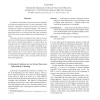Free Online Productivity Tools
i2Speak
i2Symbol
i2OCR
iTex2Img
iWeb2Print
iWeb2Shot
i2Type
iPdf2Split
iPdf2Merge
i2Bopomofo
i2Arabic
i2Style
i2Image
i2PDF
iLatex2Rtf
Sci2ools
RE
2007
Springer
2007
Springer
Scenarios: Identifying Missing Objects and Actions by Means of Computational Linguistics
In industrial requirements documents natural language is the main presentation means. In such documents, system behavior is specified in the form of scenarios, written as a sequence of sentences in natural language. The scenarios are often incomplete: For the authors of requirements documents some facts are so obvious that they forget to mention them. This surely causes problems for the requirements analyst. This paper presents an approach that analyzes textual scenarios with the means of computational linguistics, identifies where communicating objects or whole actions are missing in the text, completes the missing information, and creates a message sequence chart (MSC) including the information missing in the textual scenario. Finally, this MSC is presented to the requirements analyst for validation. The paper presents also a case study in which scenarios from a requirement document based on industrial specifications were translated to MSCs. The case study shows the feasibility o...
| Added | 09 Jun 2010 |
| Updated | 09 Jun 2010 |
| Type | Conference |
| Year | 2007 |
| Where | RE |
| Authors | Leonid Kof |
Comments (0)

